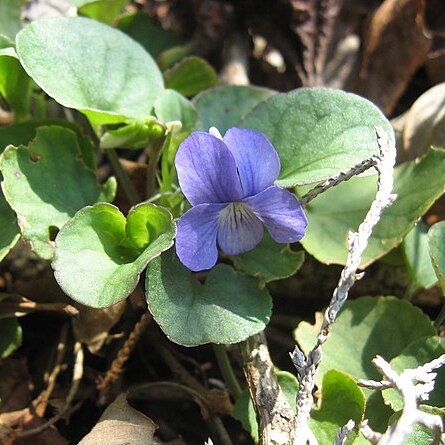Plants perennial, caulescent, stoloniferous, 5–19 cm; stolons green or reddish, leafy, sometimes rooting at nodes, becoming lignified in age. Stems 1–5, prostrate, spreading, finely puberulent, from current and/or previous year’s growth, on usually vertical, fleshy rhizome, rooting and forming rosettes at or near tip; rooted rosettes often develop into an erect, fleshy caudex from which new stems are produced. Leaves basal and cauline; basal: 3–6; stipules lanceolate, margins laciniate, projections often long-filamentous, apex long-acuminate; petiole 2.3–7.3 cm, glabrous or pubescent; blade often purple-spotted abaxially and/or adaxially, ovate to reniform, 1.2–5 × 1.6–3.6 cm, base deeply to broadly cordate, margins crenulate to serrate, ciliate or eciliate, apex rounded to obtuse, surfaces glabrous or pubescent; cauline similar to basal except: stipules ovate to lanceolate, margins laciniate; petiole 1–3.5 cm; blade 1.3–2.9 × 1.4–3.2 cm. Peduncles 5–9.6 cm, glabrous or pubescent. Flowers: sepals lanceolate to ovate, margins mostly eciliate, auricles 0.5–1 mm; petals pale to bluish violet on both surfaces, lower 3 white basally and darker violet-veined, lateral 2 and often upper 2 and lowest bearded, lowest 15–18 mm, spur white, gibbous to usually elongated, 3–5 mm; style head bearded; cleistogamous flowers axillary. Capsules ovoid to ellipsoid, 5–7 mm, glabrous. Seeds brown, 1–1.5 mm. 2n = 20.
More
Finely puberulent throughout; stems several, at first upright, later prostrate and with cleistogamous fls, and terminating in a rosette that bears petaliferous fls the next year; lvs orbicular, 2–3 × 3–4 cm, blunt, cordate at base, often purplish beneath especially on the veins; stipules sparsely fimbriate-toothed; fls on long, slender peduncles arising from the basal rosette and later from the lower axils of the elongating stems; pet light violet with darker veins, the lateral ones bearded, the spur 3–4 mm; style slender, bent at the tip, or with a terminal cusp at right angles to the axis; frs 4–5 mm, ellipsoid-globose; seeds light brown; 2n=20. Dry or moist woods and ledges; s. O. to Va., s. to Fla., Ark., and Tex. Apr., May.

